PCI Express Base Specification, Rev. 1.0
Objective of the Specification
Document Organization
Documentation Conventions
Capitalization
Numbers and Number Bases
Implementation Notes
Terms and Acronyms
Reference Documents
1. Introduction
1.1. A Third Generation I/O Interconnect
1.2. PCI Express Link
1.3. PCI Express Fabric Topology
1.3.1. Root Complex
1.3.2. Endpoints
1.3.2.1. Legacy Endpoint Rules
1.3.2.2. PCI Express Endpoint Rules
1.3.3. Switch
1.3.4. PCI Express-PCI Bridge
1.4. PCI Express Fabric Topology Configuration
1.5. PCI Express Layering Overview
1.5.1. Transaction Layer
1.5.2. Data Link Layer
1.5.3. Physical Layer
1.5.4. Layer Functions and Services
1.5.4.1. Transaction Layer Services
1.5.4.2. Data Link Layer Services
1.5.4.3. Physical Layer Services
1.5.4.4. Inter-Layer Interfaces
1.5.4.4.1. Transaction/Data Link Interface
1.5.4.4.2. Data Link/Physical Interface
1.6. Advanced Peer-to-Peer Communication Overview
2. Transaction Layer Specification
2.1. Transaction Layer Overview
2.1.1. Address Spaces, Transaction Types, and Usage
2.1.1.1. Memory Transactions
2.1.1.2. I/O Transactions
2.1.1.3. Configuration Transactions
2.1.1.4. Message Transactions
2.1.2. Packet Format Overview
2.2. Transaction Layer Protocol - Packet Definition
2.2.1. Common Packet Header Fields
2.2.2. TLPs with Data Payloads - Rules
2.2.3. TLP Digest Rules
2.2.4. Routing and Addressing Rules
2.2.4.1. Address Based Routing Rules
2.2.4.2. ID Based Routing Rules
2.2.5. First/Last DW Byte Enable Rules
2.2.6. Transaction Descriptor
2.2.6.1. Overview
2.2.6.2. Transaction Descriptor – Transaction ID Field
2.2.6.3. Transaction Descriptor – Attributes Field
2.2.6.4. Relaxed Ordering Attribute
2.2.6.5. No Snoop Attribute
2.2.6.6. Transaction Descriptor – Traffic Class Field
2.2.7. Memory, I/O, and Configuration Request Rules
2.2.8. Message Request Rules
2.2.8.1. Baseline Message Group
2.2.8.1.1. INTx Interrupt Signaling - Rules
2.2.8.1.2. Power Management Messages
2.2.8.1.3. Error Signaling Messages
2.2.8.1.4. Locked Transactions Support
2.2.8.1.5. Slot Power Limit Support
2.2.8.1.6. Vendor_Defined Messages
2.2.8.1.7. Hot Plug Signaling Messages
2.2.8.2. Advanced Switching Support Message Group
2.2.9. Completion Rules
2.3. Handling of Received TLPs
2.3.1. Request Handling Rules
2.3.1.1. Data Return for Read Requests
2.3.2. Completion Handling Rules
2.4. Transaction Ordering
2.5. Virtual Channel (VC) Mechanism
2.5.1. Virtual Channel Identification (VC ID)
2.5.2. TC to VC Mapping
2.5.3. VC and TC Rules
2.6. Ordering and Receive Buffer Flow Control
2.6.1. Flow Control Rules
2.6.1.1. FC Information Tracked by Transmitter
2.6.1.2. FC Information Tracked by Receiver
2.7. Data Integrity
2.7.1. ECRC Rules
2.7.2. Error Forwarding
2.7.2.1. Error Forwarding Usage Model
2.7.2.2. Rules For Use of Data Poisoning
2.8. Completion Timeout Mechanism
2.9. Link Status Dependencies
2.9.1. Transaction Layer Behavior in DL_Down Status
2.9.2. Transaction Layer Behavior in DL_Up Status
3. Data Link Layer Specification
3.1. Data Link Layer Overview
3.2. Data Link Control and Management State Machine
3.2.1. Data Link Control and Management State Machine Rules
3.3. Flow Control Initialization Protocol
3.3.1. Flow Control Initialization State Machine Rules
3.4. Data Link Layer Packets (DLLPs)
3.4.1. Data Link Layer Packet Rules
3.5. Data Integrity
3.5.1. Introduction
3.5.2. LCRC, Sequence Number, and Retry Management (TLP Transmitter)
3.5.2.1. LCRC and Sequence Number Rules (TLP
3.5.3. LCRC and Sequence Number (TLP Receiver)
3.5.3.1. LCRC and Sequence Number Rules (TLP Receiver)
4. Physical Layer Specification
4.1. Introduction
4.2. Logical Sub-block
4.2.1. Symbol Encoding
4.2.1.1. Serialization and De-serialization of Data
4.2.1.2. Special Symbols for Framing and Link Management
4.2.1.3. 8b/10b Decode Rules
4.2.2. Framing and Application of Symbols to Lanes
4.2.2.1. Framing and Application of Symbols to Lanes –
4.2.3. Data Scrambling
4.2.4. Link Initialization and Training
4.2.4.1. Training Sequence Ordered-sets
4.2.4.2. Lane Polarity Inversion
4.2.4.3. Fast Training Sequence (FTS)
4.2.4.4. Link Error Recovery
4.2.4.5. Link Reset
4.2.4.5.1. Physical Layer Reset (“Power Good”)
4.2.4.5.2. Training Control Reset (Hot Reset)
4.2.4.6. Link Disable
4.2.4.7. Link Data Rate Negotiation
4.2.4.8. Link Width and Lane Sequence Negotiation
4.2.4.8.1. Required/Optional Port Behavior
4.2.4.8.2. Steps to Negotiate the Width and Lane Ordering of Links
4.2.4.8.3. Port to Port Width Negotiation Example
4.2.4.9. Lane-to-Lane De- skew
4.2.4.10. Lane vs. Link Training
4.2.5. Link Training and Status State Machine (LTSSM)
4.2.5.1. Detect
4.2.5.2. Polling
4.2.5.3. Configuration
4.2.5.4. Recovery
4.2.5.5. L0
4.2.5.6. L0s
4.2.5.7. L1
4.2.5.8. L2
4.2.5.9. External Loopback
4.2.5.10. Disabled
4.2.5.11. Training Control Reset
4.2.6. Link Training and Status State Descriptions
4.2.6.1. Detect
4.2.6.1.1. Detect.Quiet
4.2.6.1.2. Detect.Active
4.2.6.1.3. Detect.Charge
4.2.6.2. Polling
4.2.6.2.1. Polling.Quiet
4.2.6.2.2. Polling.Active
4.2.6.2.3. Polling.Compliance
4.2.6.2.4. Polling.Configuration
4.2.6.2.5. Polling.Speed
4.2.6.3. Configuration
4.2.6.3.1. Config.RcvrCfg
4.2.6.3.2. Config.Idle
4.2.6.4. Recovery
4.2.6.4.1. Recovery.RcvrLock
4.2.6.4.2. Recovery.RcvrCfg
4.2.6.4.3. Recovery.Idle
4.2.6.5. L0
4.2.6.6. L0s
4.2.6.6.1. Receiver L0s
4.2.6.6.1.1. Rx_L0s.Entry
4.2.6.6.1.2. Rx_L0s.Idle
4.2.6.6.1.3. Rx_L0s.FTS
4.2.6.6.2. Transmitter L0s
4.2.6.6.2.1. Tx_L0s.Entry
4.2.6.6.2.2. Tx_L0s.Idle
4.2.6.6.2.3. Tx_L0s.FTS
4.2.6.7. L1
4.2.6.7.1. L1.Entry
4.2.6.7.2. L1.Idle
4.2.6.8. L2
4.2.6.8.1. L2.Idle
4.2.6.8.2. L2.Detect
4.2.6.8.3. L2.TransmitWake
4.2.6.9. Disabled
4.2.6.10. Loopback
4.2.6.10.1. Loopback.Entry
4.2.6.10.2. Loopback.Active
4.2.6.10.3. Loopback.Exit
4.2.6.11. Training Control Reset
4.2.6.11.1. Training Control Reset Active
4.2.7. Clock Tolerance Compensation
4.2.8. Compliance Pattern
4.3. Electrical Sub-Block
4.3.1. Electrical Sub-Block Requirements
4.3.1.1. Clocking Dependencies
4.3.1.1.1. Spread Spectrum Clock (SSC) Sources
4.3.1.2. AC Coupling
4.3.1.3. Interconnect
4.3.1.4. Termination
4.3.1.5. DC Common Mode Voltage
4.3.1.6. ESD
4.3.1.7. Short Circuit Requirements
4.3.1.8. Receiver Detection
4.3.1.9. Disable/ Surprise Removal Detection
4.3.1.10. Electrical Idle
4.3.2. Electrical Signal Specifications
4.3.2.1. Loss
4.3.2.2. Jitter and BER
4.3.2.3. De-emphasis
4.3.2.4. Beacon
4.3.2.4.1. Beacon Example
4.3.3. Differential Transmitter (TX) Output Specifications
4.3.3.1. Transmitter Compliance Eye Diagram
4.3.3.2. Compliance Test and Measurement Load
4.3.4. Differential Receiver (RX) Input Specifications
5. Power Management
5.1. Overview
5.1.1. Statement of Requirements
5.2. Link State Power Management
5.3. PCI-PM Software Compatible Mechanisms
5.3.1. Device Power Management States (D-States) of a Function
5.3.1.1. D0 State
5.3.1.2. D1 State
5.3.1.3. D2 State
5.3.1.4. D3 State
5.3.1.4.1. D3hot State
5.3.1.4.2. D3cold State
5.3.2. PM Software Control of the Link Power Management State
5.3.2.1. Entry into the L1 State
5.3.2.2. Exit from L1 State
5.3.2.3. Entry into the L2/ L3 Ready State
5.3.3. Power Management Event Mechanisms
5.3.3.1. Motivation
5.3.3.2. Link Reactivation
5.3.3.2.1. PME Synchronization
5.3.3.3. PM_PME Messages
5.3.3.3.1. PM_PME “Backpressure” Deadlock Avoidance
5.3.3.4. PME Rules
5.3.3.5. PM_PME Delivery State Machine
5.4. Native PCI Express Power Management Mechanisms
5.4.1. Active-State Power Management
5.4.1.1. L0s Active State Link Power Management State
5.4.1.1.1. Entry to L0s State
5.4.1.1.2. Exit from L0s State
5.4.1.2. L1 Active State Link Power Management State
5.4.1.2.1. Entry to L1 State
5.4.1.2.2. Exit from L1 State
5.4.1.3. Active State Link PM Configuration
5.4.1.3.1. Software Flow for Enabling Active State Link Power Management
5.5. Auxiliary Power Support
5.5.1. Auxiliary Power Enabling
5.6. Power Management System Messages and DLLPs
6. System Architecture
6.1. Interrupt and PME Support
6.1.1. Rationale for PCI Express Interrupt Model
6.1.2. PCI Compatible INTx Emulation
6.1.3. INTx Emulation Software Model
6.1.4. Message Signaled Interrupt (MSI) Support
6.1.5. PME Support
6.1.6. Native PME Software Model
6.1.7. Legacy PME Software Model
6.1.8. Operating System Power Management Notification
6.1.9. PME Routing Between PCI Express and PCI Hierarchies
6.2. Error Signaling and Logging
6.2.1. Scope
6.2.2. Error Classification
6.2.2.1. Correctable Errors
6.2.2.2. Uncorrectable Errors
6.2.2.2.1. Fatal Errors
6.2.2.2.2. Non-Fatal Errors
6.2.3. Error Signaling
6.2.3.1. Completion Status
6.2.3.2. Error Messages
6.2.3.2.1. Uncorrectable Error Severity Programming (Advanced Error Reporting)
6.2.3.2.2. Masking Error Messages
6.2.3.2.3. Error Pollution
6.2.4. Error Logging
6.2.4.1. Root Complex Considerations (Advanced Error
6.2.4.2. Multiple Error Handling (Advanced Error Reporting
6.2.5. Sequence of Device Error Signaling and Logging Operations
6.2.6. Error Listing and Rules
6.2.6.1. PCI Mapping
6.2.7. Virtual PCI Bridge Error Handling
6.2.7.1. Error Forwarding and PCI Mapping for Bridge -
6.3. Virtual Channel Support
6.3.1. Introduction and Scope
6.3.2. TC/VC Mapping and Example Usage
6.3.3. VC Arbitration
6.3.3.1. Traffic Flow and Switch Arbitration Model
6.3.3.2. VC Arbitration
6.3.3.2.1. Strict Priority Arbitration Model
6.3.3.2.2. Round Robin Arbitration Model
6.3.3.3. Port Arbitration
6.3.4. Isochronous Support
6.3.4.1. Rules for Software Configuration
6.3.4.2. Rules for Requesters
6.3.4.3. Rules for Completers
6.3.4.4. Rules for Switch Components
6.4. Device Synchronization
6.5. Locked Transactions
6.5.1. Introduction
6.5.2. Initiation and Propagation of Locked Transactions - Rules
6.5.3. Switches and Lock - Rules
6.5.4. PCI Express/PCI Bridges and Lock - Rules
6.5.5. Root Complex and Lock - Rules
6.5.6. Legacy Endpoints
6.5.7. PCI Express Endpoints
6.6. PCI Express Reset - Rules
6.7. PCI Express Native Hot Plug Support
6.7.1. PCI Express Hot Plug Usage Model
6.7.1.1. Usage Model Rationale
6.7.1.2. Elements of the Standard Usage Model
6.7.1.2.1. Indicators
6.7.1.2.1.1. Attention Indicator
6.7.1.2.1.2. Power Indicator
6.7.1.2.2. Manually-operated Retention Latch (MRL)
6.7.1.2.3. MRL Sensor
6.7.1.2.4. Electromechanical Interlock
6.7.1.2.5. Attention Button
6.7.1.2.6. Software User Interface
6.7.1.2.7. Slot Numbering
6.7.2. Event Behavior
6.7.3. Port Registers Grouped by Device Association
6.7.3.1. Attention Button Registers
6.7.3.2. Attention Indicator Registers
6.7.3.3. Power Indicator Registers
6.7.3.4. Power Controller Registers
6.7.3.5. Presence Detect Registers
6.7.3.6. MRL Sensor Registers
6.7.3.7. Command Completed Registers
6.7.3.8. Port Capabilities and Slot Information Registers
6.7.3.9. Hot Plug Interrupt Control Register
6.7.4. Hot Plug Registers on Devices
6.7.5. Messages
6.7.5.1. Messages for Attention Indicator
6.7.5.2. Messages for Power Indicator
6.7.5.3. Messages for Attention Button
6.7.6. Hot Plug Slot Register Requirements
6.7.7. PCI Express Hot Plug Interrupt/Wake Signal Logic
6.7.8. The Operating System Hot Plug Method
6.8. Power Budgeting Capability
6.8.1. System Power Budgeting Process Recommendations
6.9. Slot Power Limit Control
7. Software Initialization and Configuration
7.1. Configuration Topology
7.2. PCI Express Configuration Mechanisms
7.2.1. PCI 2.3 Compatible Configuration Mechanism
7.2.2. PCI Express Enhanced Configuration Mechanism
7.2.2.1. Host Bridge Requirements
7.2.2.2. PCI Express Device Requirements
7.2.3. Root Complex Register Block
7.3. Configuration Transaction Rules
7.3.1. Device Number
7.3.2. Configuration Transaction Addressing
7.3.3. Configuration Request Routing Rules
7.3.4. PCI Special Cycles
7.4. Configuration Register Types
7.5. PCI-Compatible Configuration Registers
7.5.1. Type 0/1 Common Configuration Space
7.5.1.1. Command Register (Offset 04h)
7.5.1.2. Status Register (Offset 06h)
7.5.1.3. Cache Line Size Register (Offset 0Ch)
7.5.1.4. Master Latency Timer Register (Offset 0Dh)
7.5.1.5. Interrupt Line Register (Offset 3Ch)
7.5.1.6. Interrupt Pin Register (Offset 3Dh)
7.5.1.7. Error Registers
7.5.2. Type 0 Configuration Space Header
7.5.2.1. Min_Gnt/ Max_ Lat Registers (Offset 3Eh/3Fh)
7.5.3. Type 1 Configuration Space Header
7.5.3.1. Secondary Latency Timer (Offset 1Bh)
7.5.3.2. Secondary Status Register (Offset 1Eh)
7.5.3.3. Bridge Control Register (Offset 3Eh)
7.6. PCI Power Management Capability Structure
7.7. MSI Capability Structure
7.8. PCI Express Capability Structure
7.8.1. PCI Express Capability List Register (Offset 00h)
7.8.2. PCI Express Capabilities Register (Offset 02h)
7.8.3. Device Capabilities Register (Offset 04h)
7.8.4. Device Control Register (Offset 08h)
7.8.5. Device Status Register (Offset 0Ah)
7.8.6. Link Capabilities Register (Offset 0Ch)
7.8.7. Link Control Register (Offset 10h)
7.8.8. Link Status Register (Offset 12h)
7.8.9. Slot Capabilities Register (Offset 14h)
7.8.10. Slot Control Register (Offset 18h)
7.8.11. Slot Status Register (Offset 1Ah)
7.8.12. Root Control Register (Offset 1Ch)
7.8.13. Root Status Register (Offset 20h)
7.9. PCI Express Extended Capabilities
7.9.1. Extended Capabilities in Configuration Space
7.9.2. Extended Capabilities in the Root Complex Register Block
7.9.3. PCI Express Enhanced Capability Header
7.10. Advanced Error Reporting Capability
7.10.1. Advanced Error Reporting Enhanced Capability Header (Offset 00h)
7.10.2. Uncorrectable Error Status Register (Offset 04h)
7.10.3. Uncorrectable Error Mask Register (Offset 08h)
7.10.4. Uncorrectable Error Severity Register (Offset 0Ch)
7.10.5. Correctable Error Status Register (Offset 10h)
7.10.6. Correctable Error Mask (Offset 14h)
7.10.7. Advanced Error Capabilities and Control Register (Offset 18h)
7.10.8. Header Log Register (Offset 1Ch)
7.10.9. Root Error Command Register (Offset 2Ch)
7.10.10. Root Error Status Register (Offset 30h)
7.10.11. Error Source Identification Register (Offset 34h)
7.11. Virtual Channel Capability
7.11.1. Virtual Channel Enhanced Capability Header
7.11.2. Port VC Capability Register 1
7.11.3. Port VC Capability Register 2
7.11.4. Port VC Control Register
7.11.5. Port VC Status Register
7.11.6. VC Resource Capability Register
7.11.7. VC Resource Control Register
7.11.8. VC Resource Status Register
7.11.9. VC Arbitration Table
7.11.10. Port Arbitration Table
7.12. Device Serial Number Capability
7.12.1. Device Serial Number Enhanced Capability Header (Offset 00h)
7.12.2. Serial Number Register (Offset 04h)
7.13. Power Budgeting Capability
7.13.1. Power Budgeting Enhanced Capability Header (Offset 00h)
7.13.2. Data Select Register (Offset 04h)
7.13.3. Data Register (Offset 08h)
7.13.4. Power Budget Capability Register (Offset 0Ch)
A. Isochronous Applications
A.1. Introduction
A.2. Isochronous Contract and Contract Parameters
A.2.1. Isochronous Time Period and Isochronous Virtual Timeslot
A.2.2. Isochronous Payload Size
A.2.3 Isochronous Transaction Lateny
A.2.4. Isochronous Transaction Latency
A.2.5. An Example Illustrating Isochronous Parameters
A.3. Isochronous Transaction Rules
A.4. Transaction Ordering
A.5. Isochronous Data Coherency
A.6. Flow Control
A.7. Considerations for Bandwidth Allocation
A.7.1. Isochronous Bandwidth of PCI Express Links
A.7.2. Isochronous Bandwidth of Endpoint Devices
A.7.3. Isochronous Bandwidth of Switches
A.7.4. Isochronous Bandwidth of Root Complex
A.8. Considerations for PCI Express Components
A.8.1. A PCI Express Endpoint Device as a Requester
A.8.2. A PCI Express Endpoint Device as a Completer
A.8.3. Switches
A.8.4. Root Complex
B. Symbol Encoding
C. Physical Layer Appendix
C.1. Data Scrambling
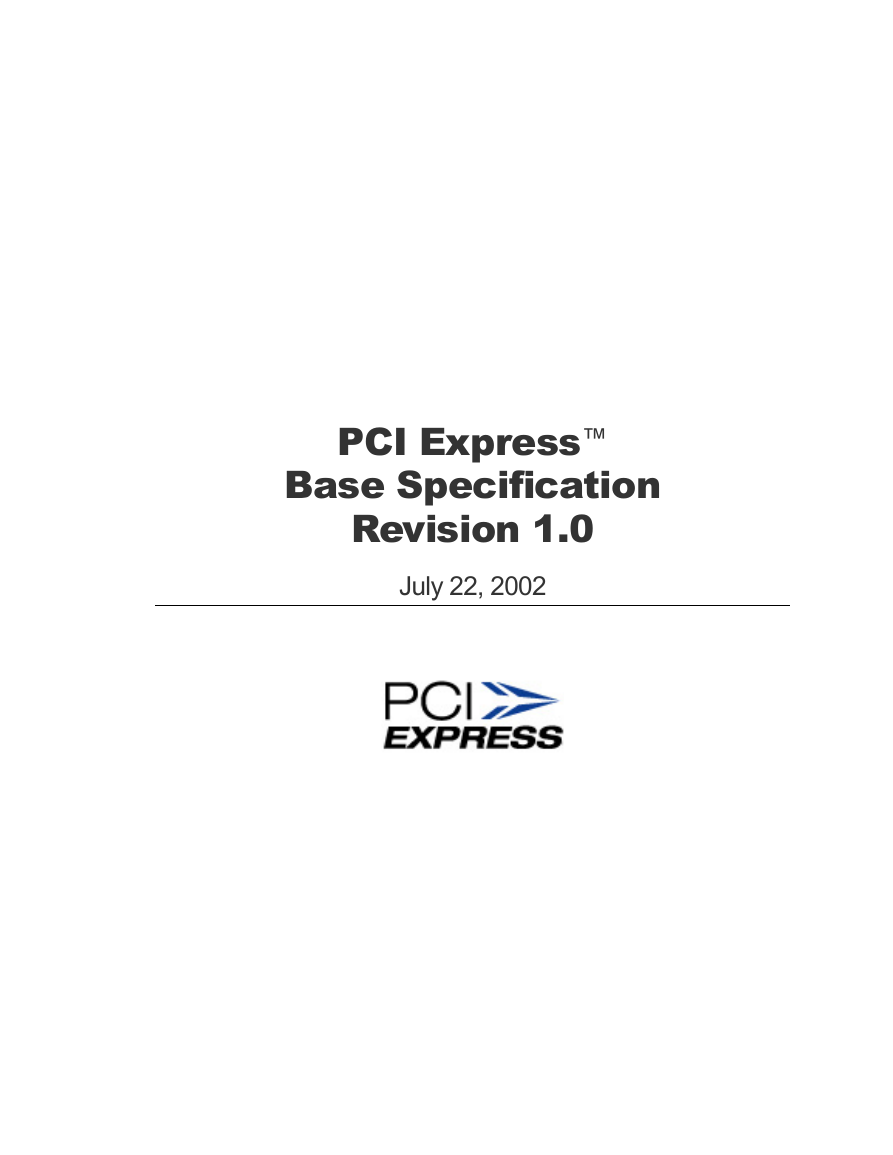
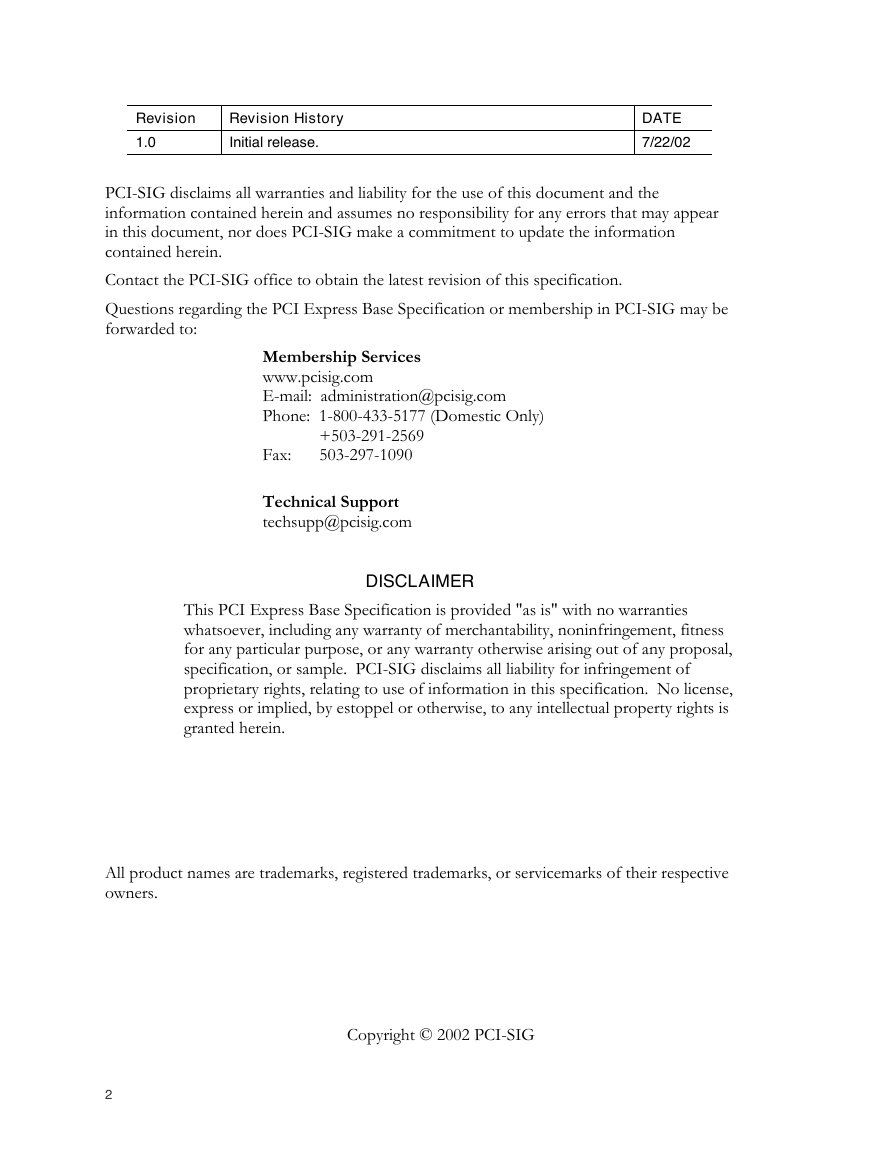
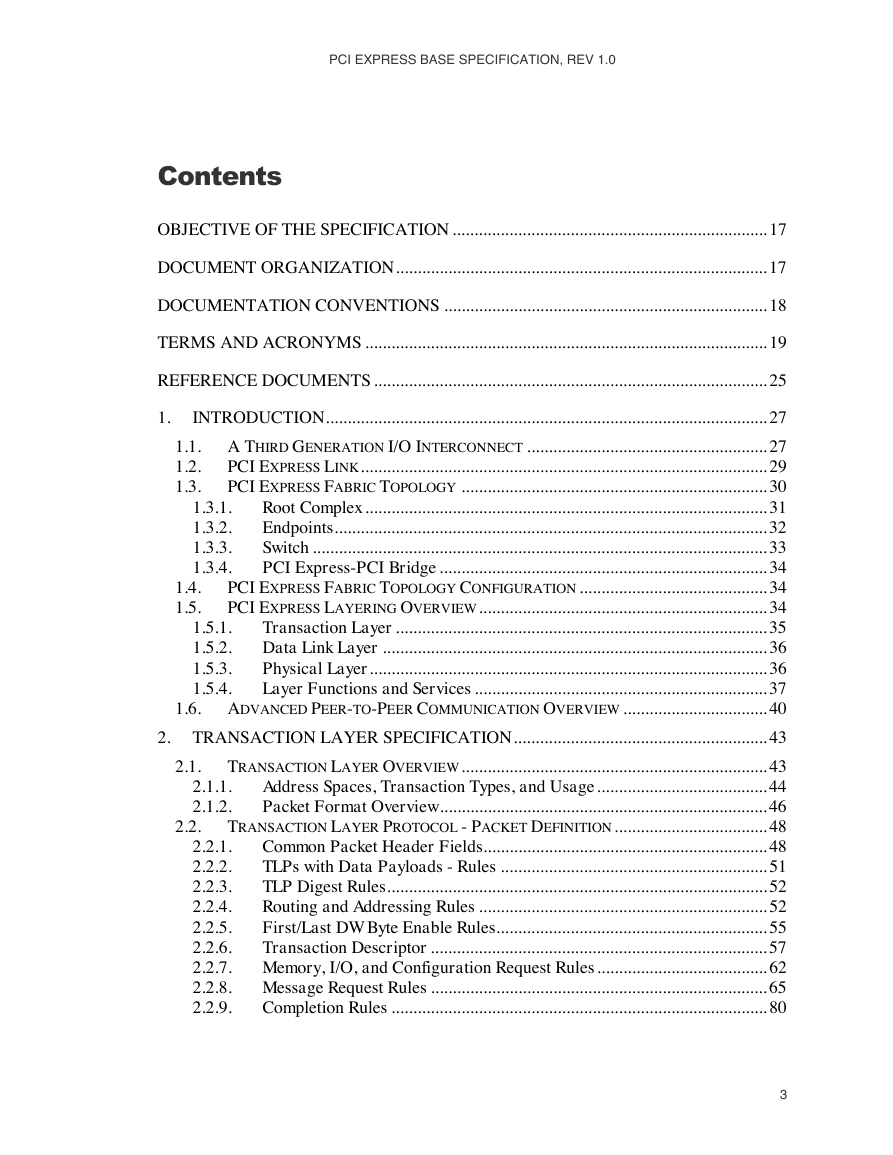
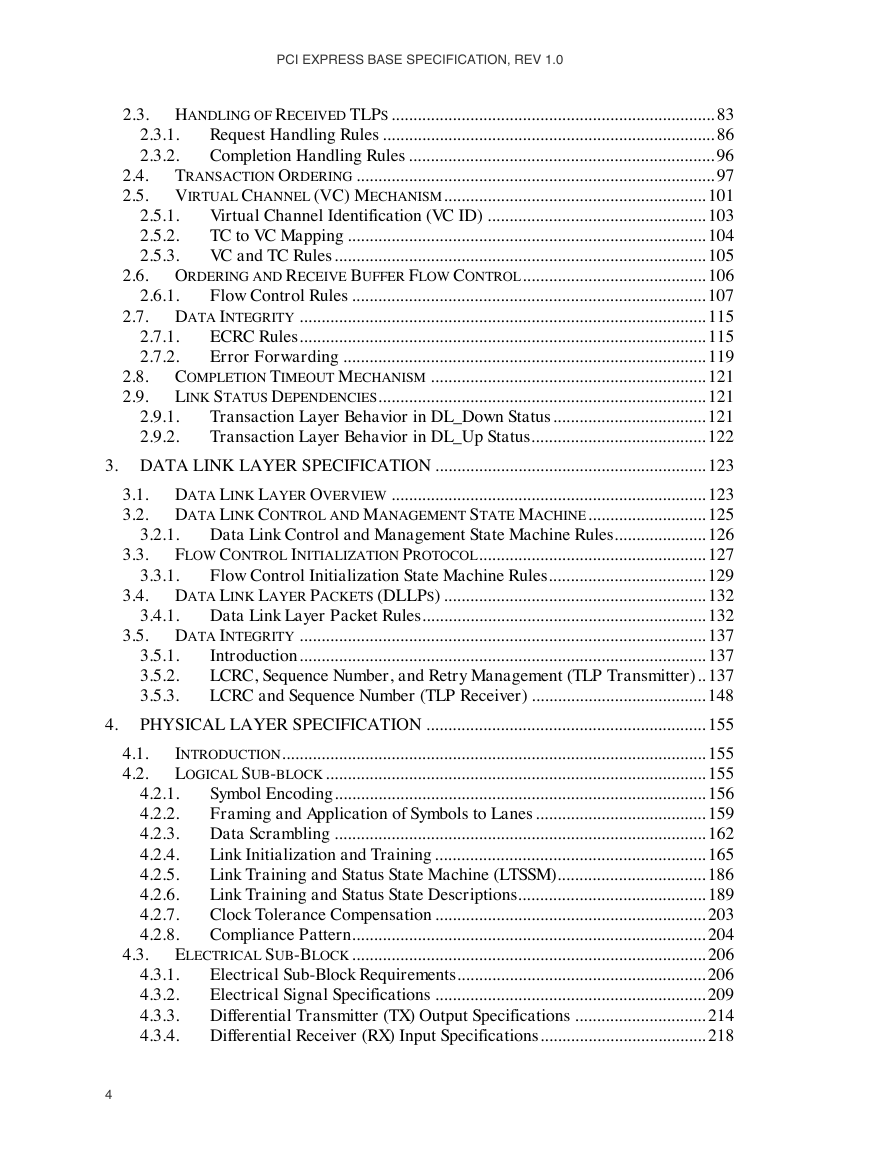
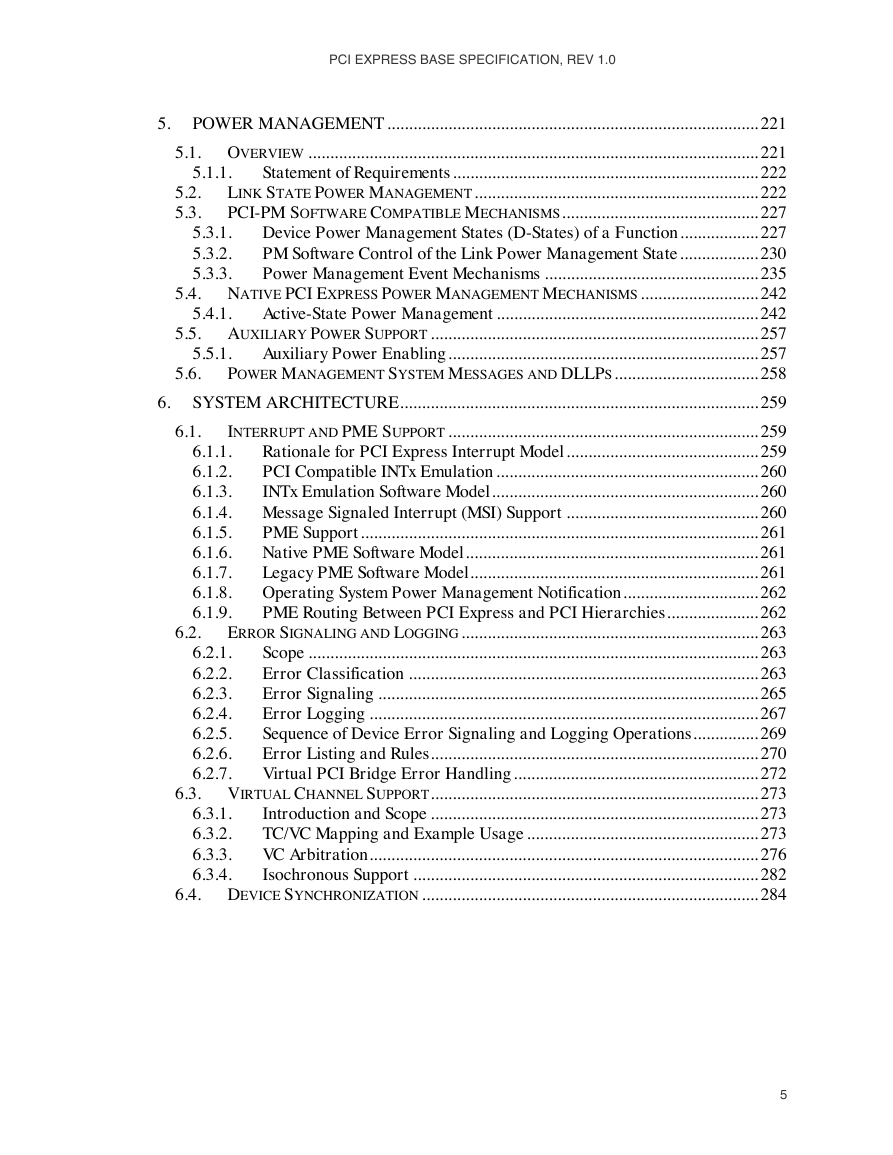
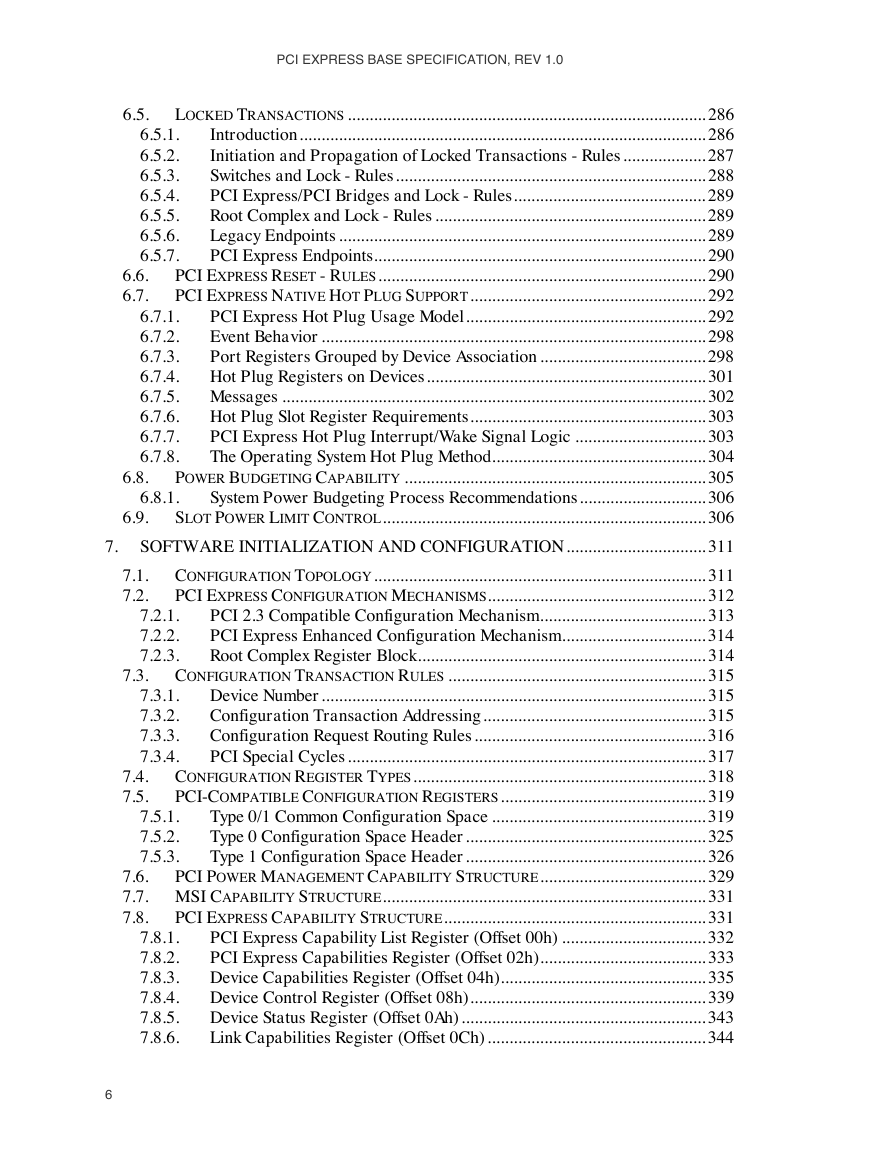
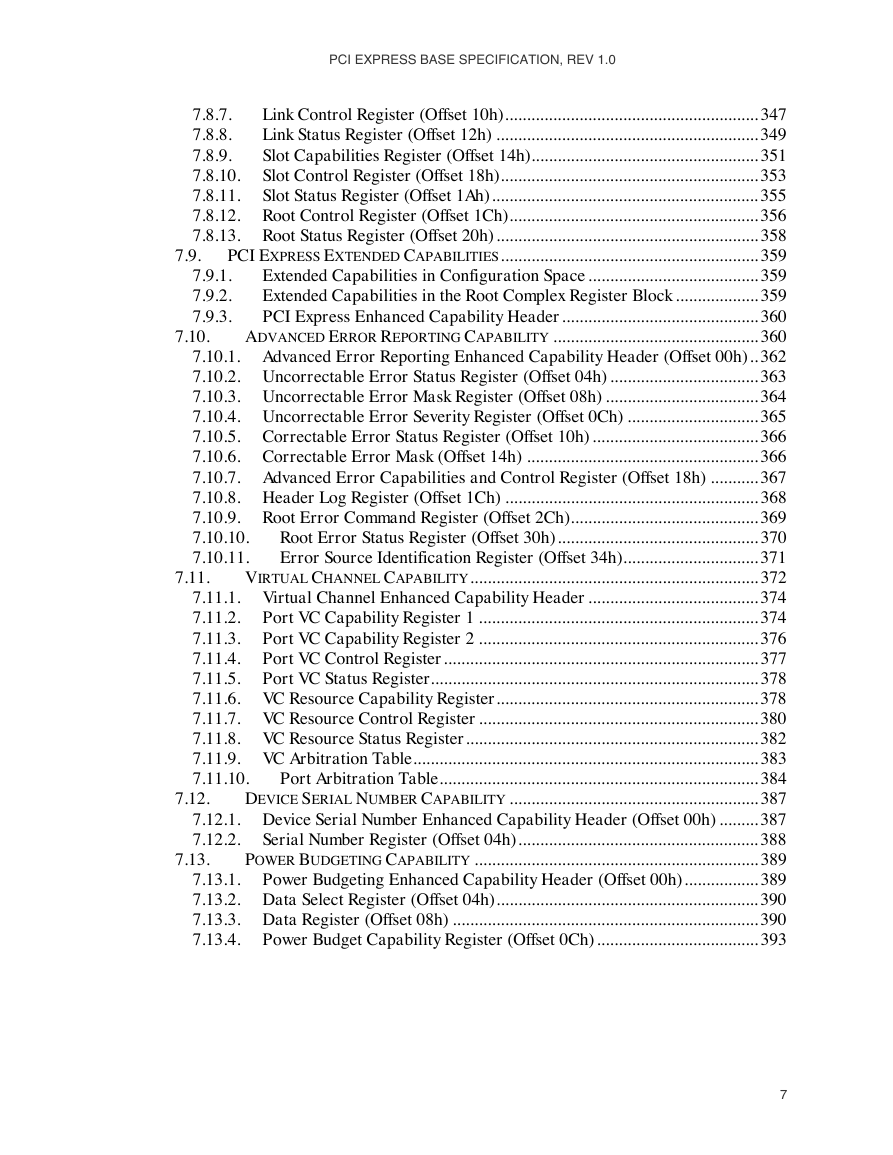









 2023年江西萍乡中考道德与法治真题及答案.doc
2023年江西萍乡中考道德与法治真题及答案.doc 2012年重庆南川中考生物真题及答案.doc
2012年重庆南川中考生物真题及答案.doc 2013年江西师范大学地理学综合及文艺理论基础考研真题.doc
2013年江西师范大学地理学综合及文艺理论基础考研真题.doc 2020年四川甘孜小升初语文真题及答案I卷.doc
2020年四川甘孜小升初语文真题及答案I卷.doc 2020年注册岩土工程师专业基础考试真题及答案.doc
2020年注册岩土工程师专业基础考试真题及答案.doc 2023-2024学年福建省厦门市九年级上学期数学月考试题及答案.doc
2023-2024学年福建省厦门市九年级上学期数学月考试题及答案.doc 2021-2022学年辽宁省沈阳市大东区九年级上学期语文期末试题及答案.doc
2021-2022学年辽宁省沈阳市大东区九年级上学期语文期末试题及答案.doc 2022-2023学年北京东城区初三第一学期物理期末试卷及答案.doc
2022-2023学年北京东城区初三第一学期物理期末试卷及答案.doc 2018上半年江西教师资格初中地理学科知识与教学能力真题及答案.doc
2018上半年江西教师资格初中地理学科知识与教学能力真题及答案.doc 2012年河北国家公务员申论考试真题及答案-省级.doc
2012年河北国家公务员申论考试真题及答案-省级.doc 2020-2021学年江苏省扬州市江都区邵樊片九年级上学期数学第一次质量检测试题及答案.doc
2020-2021学年江苏省扬州市江都区邵樊片九年级上学期数学第一次质量检测试题及答案.doc 2022下半年黑龙江教师资格证中学综合素质真题及答案.doc
2022下半年黑龙江教师资格证中学综合素质真题及答案.doc